SEXTON BLAKE ON THE FILMS
by Walter Webb
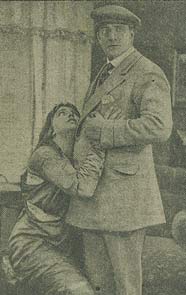 Part 1: The Silent Days
Part 1: The Silent Days
Make a note of all the films which have brought the character of Sexton Blake to the screen, endeavour to select just one which was worth the time, trouble and expense of producing, and the result of such an undertaking must inevitably be a negative shaking of the head. To say that those Blake films were poor is to understate; they ranged from mediocrity to rank bad productions and were, with hardly an exception, an insult to the intelligence of the average film-goer. Situations which were supposed to be thrilling and were intended to make audiences grip their seats with suspense only brought involuntary laughter, for some of the attempts to build up an atmosphere of tension and excitement were so crude that the results achieved were quite absurd. Maybe Hollywood's offerings of the Sherlock Holmes films were not extraordinary examples of cinematographic achievements but they were super-productions compared to the sorry efforts of British producers who sought to boost Sexton Blake in the same medium.
The dismal record began just before the commencement of the first world war when, on 6 April 1914, a three-reel film called THE CLUE OF THE WAX VESTA was generally released for showing. It was adapted from the first few Yvonne stories, and "stills" from the film were reproduced in the pages of the UNION JACK and PLUCK by an enthusiastic editor who urged his readers to get in touch with their local cinema manager at once and request him to show the film; for, according to him, the production was a hit which every Sexton Blake fan should not miss. But the enraptured editor's opinion was not shared by all his readers, some of whom wrote and told him so in no uncertain manner, one indignant follower going so far as to say that if the rest were going to be like that he would not go and see them. The editor's excuses in the face of these criticisms were somewhat lame; he pointed out that several drawbacks were encountered with this first film, one being that they were strange to the art of filming their stories, and another that it was acted abroad. Seeing that quite a lot of the action in the Yvonne stories did take place abroad a puzzled Blake fan might quite naturally ask what that had to do with it!
The second Blake film was generally released for exhibition on 7 September 1914, and was entitled THE MYSTERY OF THE DIAMOND BELT. It featured George Marsden Plummer, a very popular bad character of that period. Once again the editor boosted the film for all he was worth, emphasising the fact that this second Sexton Blake film was superior to the first by reason of the fact that it was produced in London by the finest producer in England — Mr. Charles Raymond. But, by all accounts, the film was not considered to by anything out of the ordinary, for the critics gave it a cool reception — if they bothered to mention it at all! Sexton Blake was played by Mr. Philip Kay; Tinker by the UNION JACK editor, Mr. Lewis Carlton; George Marsden Plummer by Mr. Douglas Payne; and Kitty the Moth by Miss Eve Balfour. The story of the film, written by Lewis Carlton, appeared in serial form in the Boys' Journal, commencing in the issue dated 17 October, 1914.
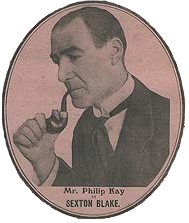 Title of the third Sexton Blake film, distributed on this occasion by Messrs. Walturdaw & Co. Ltd., was called BRITAIN'S SECRET TREATY, and it commenced its rounds of the halls during the first week of the first world war, and was adapted from the UNION JACK story by Andrew Murray — THE CASE OF THE GERMAN ADMIRAL, featuring the Hon. John Lawless.
Title of the third Sexton Blake film, distributed on this occasion by Messrs. Walturdaw & Co. Ltd., was called BRITAIN'S SECRET TREATY, and it commenced its rounds of the halls during the first week of the first world war, and was adapted from the UNION JACK story by Andrew Murray — THE CASE OF THE GERMAN ADMIRAL, featuring the Hon. John Lawless.
Following immediately upon this was the film THE STOLEN HEIRLOOMS. Next in line was John William Bobin's story, entitled THE COUNTERFEITERS, which was released during the last week in November, 1915 and featured the popular characters, Ezra Q. Maitland and Broadway Kate, and, of course, Sexton Blake and Tinker, working in co-operation with Detective Inspector Martin, of Scotland Yard. This film was produced by the Davidson Film Company.
In those days films were still in the experimental stage, and it was the stars of the American film who filled the cinemas in the days of the early Sexton Blake offerings — the hilariously funny antics of the Keystone Cops, the Mack Sennett comedies, in which were featured the mirth-provoking antics of Mack Swain, Roscoe (Fatty) Arbuckle, Slim Summerville, Ben Turpin, Chester Conklin — and the most famous of them all — Charlie Chaplin.
But if there was one who outstripped even those established favourites in popularity it was Pearl White, uncrowned Queen of the Serial Film, who had a tremendous following and whose exploits brought never-to-be-forgotten thrills to millions. Never were Saturday afternoons looked so eagerly forward to by the youth of that generation — never were pennies so promptly parted with at cinemas by wildly excited and happy youngsters as on those occasions when a serial featuring the incomparable Pearl was being shown. The printed adventures of Sexton Blake, Harry Wharton & Co. Nelson Lee and other heroes, were forgotten on those thrilling occasions — UNION JACKS, PLUCKS, MARVELS, BOYS' FRIENDS, REALMS, HERALDS, MAGNETS, GEMS etc., were temporarily cast aside, for, whereas they could be perused at leisure the Pearl White episode was no longer available after the Saturday showing.
Against the sustained thrills of the American serial the Sexton Blake film had little to offer, and how puny a figure did the screen Sexton Blake compare with the virile young woman of the former! Pearl White was tall, blonde, well built and, if not exactly beautiful, remarkably good-looking, with dark expressive eyes. Most exciting and the best of all her serials was 'The Exploits of Elaine', which surviving readers of the old boys' papers may remember was shown throughout the country in the year 1915, and was written by Arthur B. Reeve, the American author. It featured Sexton Blake's counterpart in the States, Craig Kennedy, the scientific detective, a part played by Arnold Daly, a stocky not-so-young actor; Creighton Hall played the role of Jameson, a newspaper reporter and friend of Kennedy, and Pearl White was, of course, Elaine. Fifteen episodes of continual thrills, with Pearl White being stalked throughout the whole film by a fearsome-looking individual, known as The Clutching Hand, who with his face practically concealed by a handkerchief and with a paralysed hand bent in a perpetual clutch, must have chilled the blood of the hardiest film-goer. Mr. Reece, of the Criminals' Confederation, one of the most malevolent, black-hearted and double-dyed villains in fiction, was a patron saint compared to him!
Could the Sexton Blake films have given even half the entertainment the Pearl White serials did they would be remembered today with the same affection, instead of which they are forgotten, and deservedly so. Acting in the Blake films was often stilted and poor, for most of the players seemed camera-conscious, a defect entirely lacking in Pearl White and her company, whose performances were natural and smooth. And how Pearl White could act! The expression of sheer terror which distorted her attractive features as Sheldon Lewis, playing the part of Perry Bennett, the crooked lawyer, transformed himself gradually into The Clutching Hand before her eyes has not since been surpassed for stark realism.
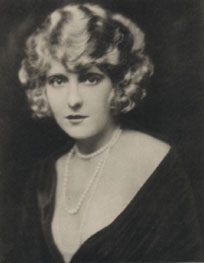 Seeing this very attractive and most assertive young woman being lassoed from a galloping horse by outlaws hiding in a tree; tightly bound and lowered head-downwards into a large tank, or vat, containing some sort of liquid which sizzled and steamed like lava from a volcano; running and swaying along the roof of a swiftly moving locomotive; or being pulled into the air clinging frantically to the trailing-rope of a balloon, it was not surprising that a marked change should be observed in the character of the heroine in the Sexton Blake stories. Hitherto they had been of the fragile, cringing, timid type of female, who were likely to swoon into the arms of their husbands, or lovers, at the merest suggestion of danger, but the advent of such heroines of the screen like the fabulous Pearl White and Ruth Roland brought about their rapid demise, and they were superseded by the more adventurous and glamorous type, such as Yvonne, Fifette, Marie Galante, Ysabel de Ferre and several others. Mark Osborne, in one of the best Sexton Blake stories he ever wrote — THE WORKINGS OF CHANCE (Union Jack No. 536, dated 17 January 1941) — went so far as to introduce a woman who combined strength with beauty — who could bend an ordinary poker easily with her own bare hands — a feminine Eugene Sandow, in fact!
Seeing this very attractive and most assertive young woman being lassoed from a galloping horse by outlaws hiding in a tree; tightly bound and lowered head-downwards into a large tank, or vat, containing some sort of liquid which sizzled and steamed like lava from a volcano; running and swaying along the roof of a swiftly moving locomotive; or being pulled into the air clinging frantically to the trailing-rope of a balloon, it was not surprising that a marked change should be observed in the character of the heroine in the Sexton Blake stories. Hitherto they had been of the fragile, cringing, timid type of female, who were likely to swoon into the arms of their husbands, or lovers, at the merest suggestion of danger, but the advent of such heroines of the screen like the fabulous Pearl White and Ruth Roland brought about their rapid demise, and they were superseded by the more adventurous and glamorous type, such as Yvonne, Fifette, Marie Galante, Ysabel de Ferre and several others. Mark Osborne, in one of the best Sexton Blake stories he ever wrote — THE WORKINGS OF CHANCE (Union Jack No. 536, dated 17 January 1941) — went so far as to introduce a woman who combined strength with beauty — who could bend an ordinary poker easily with her own bare hands — a feminine Eugene Sandow, in fact!
The war resulted in the suspension of several other planned Sexton Blake productions, and also caused enforced changes to be made in the editorial departments of the various boys' papers. L.H. Pratt was deposed temporarily in the "Sexton Blake Library" by the youthful William Home-Gall, son of the old writer of the same name, who wrote as Regional Wray, and Thomas Burke took over the "Boys Realm". The latter was to become famous soon afterwards as the author of "Limehouse Nights", which provided the foundation for the highly successful D.W. Griffith's film, "Broken Blossoms". Trevor C. Wignall, who wrote one or two Sexton Blake's and created a Japanese detective named Saburo, thereby anticipating Charlie Chan, used to wander all over London with Burke while the latter collected material for "Limehouse Nights". Together they traipsed for many months about the great city, Burke with his dog-eared manuscript under his arm, but failing to find a publisher.
William J. Elliott, another casual Sexton Blake writer, was also busy in the film world during this period and his name was to be seen in the credit-titles as the writer of the scenario in several British productions. For example, he wrote the scenario of the big production of Charles Dickens' "Bleak House", which Maurice Elvey produced in 1919, with Constance Collier in the role of Lady Deadlock. He was also responsible for the scenario of George R. Sims' famous drama of London life, "The Ever Open Door", distributed by Ideal Films Ltd., in 1920.
The next Sexton Blake film, completed by Harry Loraine for Gaumont, was trade shown at the New Gallery Kinema on 14 August 1919, and was entitled "THE FURTHER EXPLOITS OF SEXTON BLAKE — THE MYSTERY OF THE S.S. OLYMPIC". Filming took place around the Liverpool docks and a good deal of the action occurred on board the liner. An interesting fact is that when the film was being produced, the Olympic was still a troopship. The producer, however, desired to reproduce faithfully some of the cabin interiors which consisted of some very fine and expensive panelling. This panelling had been taken out of the Olympic early in the war and stored, and to help Mr. Loraine to get his settings correct, the owners of the Olympic courteously allowed him to bring the actual panelling down to London to be set up in the studio, in order to make a faithful replica of the cabin on board the vessel. The story of the film was written specially by Robert Murray for copy in the "Union Jack", and was published in issue No. 857 under the same title as the film.
Several years elapsed before the next series of Sexton Blake films went into production. Then, in 1928 Captain George Banfield, of British Filmcraft Ltd., set to work on a number of two-reelers with Langhorne Burton in the role of Sexton Blake, and Mickey Brantford playing the part of Tinker. Title of the first film in the series was THE MYSTERY OF THE SILENT DEATH, and this was followed immediately by SILKEN THREADS. Number three was called THE GREAT OFFICE MYSTERY, and the remaining three, making six in all were entitled as follows: BLAKE THE LAWBREAKER; SEXTON BLAXE, GAMBLER and THE CLUE OF THE SECOND GOBLET, which featured George Marsden Plummer. All six films were adapted from stories published in the "Union Jack", and distributed at a time when silent films were on the way out, for the "talkies" had already captured public fancy following the miracle of the first part-talking film, "The Jazz Singer" in which the voice of Al Jolson was heard in British cinemas for the first time. These Sexton Blake films were widely distrubuted and compared to those which had gone before were not too bad, but they did nothing to enhance the reputation of Mr. Langhorne Burton, a most accomplished actor.
Such is the dismal record of Sexton Blake on the silver screen - not one really worth-while production covering a period of fourteen years, which was a striking contrast to the American offerings of their own fictional detectives such as Nick Carter, Craig Kennedy, Ellery Queen, and one or two others who appeared in some quite inexpensive but really thrilling films. By the year 1930 it was obvious that the sound film had come to stay, and this gave British producers an opportunity to make some amends for their lamentable failures in the silent era, for in the not-so-distant future plans were to be put into operation whereby Sexton Blake was to go on the track again. This time, however, there would be a big difference, for the sort he was to be put on was in opposition to anything he had ever embarked on before — the sound-track of the all-talking film.
Part 2: On the Sound Track
The novelty that synchronised sound brought to motion pictures had long worn off before any decision was arrived at to make a full-length, all-talking Sexton Blake picture, and it was not until the year 1935 that a British company began work on a screen adaption of Hamilton Teed's story "They Shall Repay!", which was published in UNION JACK No. 1,378 and featured Mademoiselle Roxane. When I first saw this film in Birmingham eighteen years ago — it was called "Sexton Blake and the Mademoiselle" — it required much fortitude on my part to sit and see the whole thing through, for, like many of its predecessors, it was a drab affair, not through any fault of the artistes, but due to the material at their disposal which offered no scope at all for them to exercise their talents. Made by Metro-Goldwyn-Mayer and directed by Alex Bryce, this picture was generally released week commencing 10th February 1936, and had George Curzon playing the role of Sexton Blake and Tony Sympson as Tinker. Both were no more than adequate in their respective parts, as was Lorraine Grey as Roxane. The character of Inspector Thomas was played by Edgar Norfolk.
A bad start to the new Sexton Blake talking pictures, which was destined to be very little improved upon in the near distant future. Two years later Metro-Goldwyn-Mayer released another Blake film, entitled "Sexton Blake and the Hooded Terror", which was adapted from the SEXTON BLAKE LIBRARY story, "The Mystery of No. 13 Caversham Square", by Pierre Quiroule, and quite a number of players well known in British films appeared in the cast. George Curzon and Tony Sympson were again Sexton Blake and Tinker; Granite Grant was played by David Farrar, and Mademoiselle Julie by Greta Gynt. A notable addition to the cast was Tod Slaughter, well known for his portrayal of Sweeny Todd, the Demon Barber, who was seen in the role of a character named Michael Larran. Mrs. Bardell Blake's housekeeper, was portrayed by Marie Wright. Slightly better than the previous film but a long, long way from being a good production, and one can only sum up by recording it as a waste of time for the excellent artistes who appeared in it.
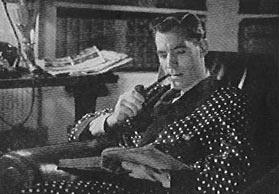 Early in 1945 came an hour and twenty minutes' offering of another film featuring the famous character, entitled "Meet Sexton Blake".David Farrar, who had played the character of Granite Grant in the previous picture, enacted the role of Sexton Blake in this one and gave quite a good performance. A young actor named John Varley played Tinker. The film was an adaption of Anthony Parsons' story, "The Case of the Stolen Despatches" (SBL no.19, new series), and was directed by John Harlow. As in most of Anthony Parsons' stories Superintendent Venner was prominently featured, as was also Sergeant Belford. Venner was played by the well-known British actor, Gordon McLeod. The character of Yvonne, who was undoubtedly the Mademoiselle Yvonne de Braselieu of the SBL stories, was played by Magda Kun, and that of Mrs. Bardell was in the capable hands of Kathleen Harrison. Hardly a brilliant bit of casting here, for although the latter is in the front rank of British's character actresses, she lacks the physical proportions necessary to make her identical in any way to Blake's generously-formed housekeeper. It was indeed a very emaciated looking Mrs. Bardell who flitted across the screen in this particular film — a film notable not so much for its quality, which was only moderate, but for the appearance of a sixteen-year-old girl, playing only her second part in pictures, who is today, both here and in America, famous for her many splendid performances in films in which she has appeared, on the strength of which she has reached well-merited stardom. In private life Mrs. Stewart Granger, she is better known as Jean Simmons.
Early in 1945 came an hour and twenty minutes' offering of another film featuring the famous character, entitled "Meet Sexton Blake".David Farrar, who had played the character of Granite Grant in the previous picture, enacted the role of Sexton Blake in this one and gave quite a good performance. A young actor named John Varley played Tinker. The film was an adaption of Anthony Parsons' story, "The Case of the Stolen Despatches" (SBL no.19, new series), and was directed by John Harlow. As in most of Anthony Parsons' stories Superintendent Venner was prominently featured, as was also Sergeant Belford. Venner was played by the well-known British actor, Gordon McLeod. The character of Yvonne, who was undoubtedly the Mademoiselle Yvonne de Braselieu of the SBL stories, was played by Magda Kun, and that of Mrs. Bardell was in the capable hands of Kathleen Harrison. Hardly a brilliant bit of casting here, for although the latter is in the front rank of British's character actresses, she lacks the physical proportions necessary to make her identical in any way to Blake's generously-formed housekeeper. It was indeed a very emaciated looking Mrs. Bardell who flitted across the screen in this particular film — a film notable not so much for its quality, which was only moderate, but for the appearance of a sixteen-year-old girl, playing only her second part in pictures, who is today, both here and in America, famous for her many splendid performances in films in which she has appeared, on the strength of which she has reached well-merited stardom. In private life Mrs. Stewart Granger, she is better known as Jean Simmons.
During the same year, just prior to Christmas, British National-Anglo American Pictures distributed a further Sexton Blake film directed by John Harlow. This one was called "The Echo Murders", based on the SBL story "The Terror of Tregarwith", by John Sylvester, published in May 1943, and once again David Farrar played the role of Sexton Blake. A notable absentee was Tinker, and neither was Mrs. Bardell featured; in fact, in this hectic but confused picture, Blake battled without the assistance of any of the various favourite supporting characters well-known to readers of the Blake papers.
This is the last Blake film to date, and at the time of writing there is no sign of any further productions featuring the famous character going before the cameras, for, without exception, they pulled in very little at the box-office. That they were poor money-spinners may be attributed to several factors; firstly, they were made as cheaply as possible; secondly, hardly one name likely to mean anything at the box-office was included in any of the productions; thirdly, selection of the stories adapted for the screen left a lot to be desired, and since they were all indifferently acted, directed and produced have long since been forgotten by the ordinary film-goer. If remembered at all it must be by the few remaining loyal readers of the Blake papers.
Looking back on the hundreds of Blake stories that have been written, it must be admitted that a vast number of them would lend themselves most unkindly to cinematographic treatment. They were written for the thriller fan, and that means principally for masculine consumption, but a film which aims solely at satisfying the male with no regard at all for the entertainment of the opposite sex is destined to flop.
The series of Sexton Blake stories ideally suited to the screen would be the Nirvana tales by Hamilton Teed, for they contain everything necessary to make good entertainment in that medium — a good plot, containing a strong human interest, with romance, adventure and crime proportionately blended. Having, with good reason, cast a vote of no confidence in British producers, I would like to see a Hollywood effort in respect of the Nirvana stories with all British players — or nearly so — in the leading roles. In the hands of a good scenario-writer these stories could be compressed into a whole to make a film — preferably in technicolour — which would appeal to the vast majority of cinema audiences. And who more suitable for this task than Barrie Lyndon, himself an old Sexton Blake writer, now resident in Hollywood, and famous for his highly successful play, "The Amazing Dr. Clitterhouse", which was not only a success on stage and screen, but was very favourably received on TV and Radio. Barrie Lyndon also wrote the scenario for that excellent and unusual film "War of the Worlds", besides several others. Better known to readers of the old boy's papers as Alfred Edgar, he was for a time editor of the Nelson Lee Library in which capacity he has not escaped a certain amount of criticism from surviving readers of that periodical. But if his editorial ventures did not meet with the success aimed for, there is no question as to his ability as a writer, and he would be just the man to write up Sexton Blake for the screen.
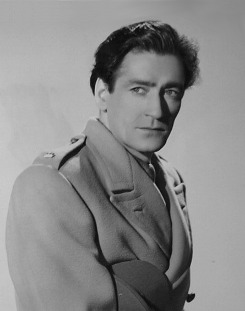 Given the job of selecting the cast I would unhesitatingly choose British actor Guy Rolfe for the role of Sexton Blake, for any Blake follower who saw this fine actor in the part of the doctor in the recent British film, distributed by Renown Pictures, "Dance, Little Lady", must have been amazed at his uncanny likeness to the character as portrayed by that talented artist, E.R.Parker in the Blake papers. Dirk Bogarde, one of the most popular young stars of the British screen, would fill the role of Tinker admirably, whilst for the part of Mademoiselle Yvonne, the beautiful young adventuress who caused such riotous disturbances in the heart of the famous detective, Maureen O'Hara has all the necessary qualifications to make the role a successful one. Finding a British star or featured player to take the part of Nirvana the waif, who did to the youthful Tinker what Yvonne did to Blake, is a much more difficult task and I find it necessary to cast across the water for the star who would do more than justice to the role. The ideal choice there would be Virgina Mayo who although American is not obviously so, and has on more than one occasion filled the part of an English girl with success, as witness her pleasing performances as Lady Barbara Wellesley in C.S. Forrester's epic of the sea, "Captain Horatio Hornblower, R.N.", and as the Lady Edith in "King Richard and the Crusaders", the screen adaption of Sir Walter Scott's famous story, "The Talisman", which is now going the rounds. As the blonde dancer who stole Tinker's heart and almost caused a break-up in the Baker Street firm, Virginia Mayo would not only look the part but would invest it with both charm and intelligence, and having no little ability as a dancer would be in her element. With a musical score added, one or two original dance numbers introduced and under capable direction a film with such a fine cast with unstinted co-operation from the technical side to do full justice to their talents, the story of Nirvana the dancer could easily be made into a first-class motion picture of wide appeal. Of course, the chances of such a film being made are practically nil, but if in some surprising manner it was made, it would go a long way towards extinguishing the unhappy memories of those cheaply produced home-made pictures which have been mentioned in this record, for there is no denying the fact that Sexton Blake has had a bad deal on celluloid — it is time he was given a break.
Given the job of selecting the cast I would unhesitatingly choose British actor Guy Rolfe for the role of Sexton Blake, for any Blake follower who saw this fine actor in the part of the doctor in the recent British film, distributed by Renown Pictures, "Dance, Little Lady", must have been amazed at his uncanny likeness to the character as portrayed by that talented artist, E.R.Parker in the Blake papers. Dirk Bogarde, one of the most popular young stars of the British screen, would fill the role of Tinker admirably, whilst for the part of Mademoiselle Yvonne, the beautiful young adventuress who caused such riotous disturbances in the heart of the famous detective, Maureen O'Hara has all the necessary qualifications to make the role a successful one. Finding a British star or featured player to take the part of Nirvana the waif, who did to the youthful Tinker what Yvonne did to Blake, is a much more difficult task and I find it necessary to cast across the water for the star who would do more than justice to the role. The ideal choice there would be Virgina Mayo who although American is not obviously so, and has on more than one occasion filled the part of an English girl with success, as witness her pleasing performances as Lady Barbara Wellesley in C.S. Forrester's epic of the sea, "Captain Horatio Hornblower, R.N.", and as the Lady Edith in "King Richard and the Crusaders", the screen adaption of Sir Walter Scott's famous story, "The Talisman", which is now going the rounds. As the blonde dancer who stole Tinker's heart and almost caused a break-up in the Baker Street firm, Virginia Mayo would not only look the part but would invest it with both charm and intelligence, and having no little ability as a dancer would be in her element. With a musical score added, one or two original dance numbers introduced and under capable direction a film with such a fine cast with unstinted co-operation from the technical side to do full justice to their talents, the story of Nirvana the dancer could easily be made into a first-class motion picture of wide appeal. Of course, the chances of such a film being made are practically nil, but if in some surprising manner it was made, it would go a long way towards extinguishing the unhappy memories of those cheaply produced home-made pictures which have been mentioned in this record, for there is no denying the fact that Sexton Blake has had a bad deal on celluloid — it is time he was given a break.
